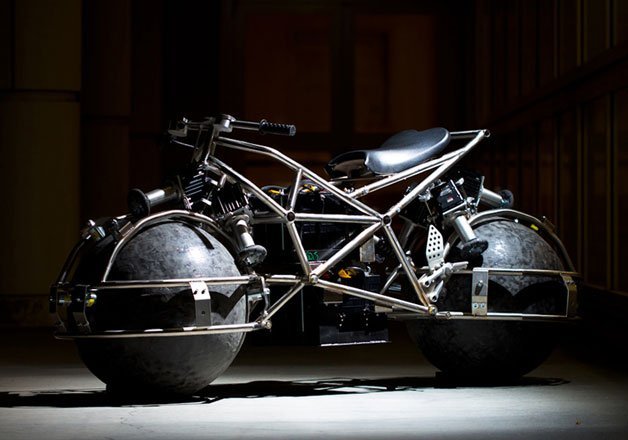Spherical Drive Motorcycle Being Developed By Engineering Students

Max Ratner, Henry Li and Andrew Parmar came up with the concept of applying an omnidirectional drive system to the motorcycle world during a brainstorming session a little over a year ago. Inspired by the self-balancing technology found in the Segway personal transport and a balancing robot developed in Tokyo, the trio of mechanical engineering students settled on applying the same principles to a motorcycle device as a proof of concept. The idea went through a number of evolutions before settling on the design you see here with two massive spheres enclosed in a tube cage.
The spheres are controlled via three electric motors that provide small inputs to keep the rig upright via some clever software. The result is a machine with a zero turning radius that anyone one can ride regardless of skill level or physical handicap. The bike can immediately change direction to move perpendicular to the previous path of travel, but Ratner, Li and Parmar want to make it clear that they aren't out to revolutionize the way vehicles travel.
"This is more of a proof of concept," Parmar said. "We want to show that something like this is actually possible."
Even so, the team sees plenty of advantages to spherical drive, including computer-aided crash avoidance and parking. The tech may also have applications outside of the automotive sector, including use in fork lifts where speed and foul weather grip aren't issues and the design's superior maneuverability could be a major asset.
The team has received substantial help from a handful of local sponsors, including Wolfe Engineering. The company fabricated the frame for the first prototype based on the team's designs and a second sponsor, Animatics, supplied the vehicle's motors as well. With the physical hardware in place, the team needs only to finish the programming to show off their creation balancing on its own and operating on a smooth surface. There are certainly disadvantages to the design, and the team seems aware of some of the largest, but for right now, it's simply impressive to see a group of college guys crank out a prototype of this caliber.
"We're taking it one step at a time," Ratner said. "Road applications are farther down the road and will require further R&D."
Nouvelles connexes


